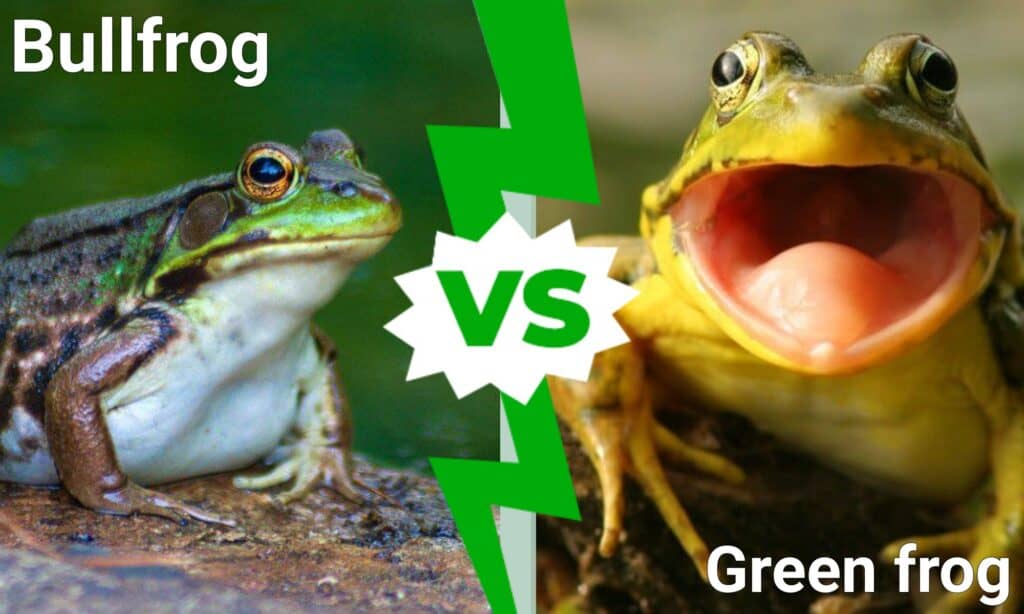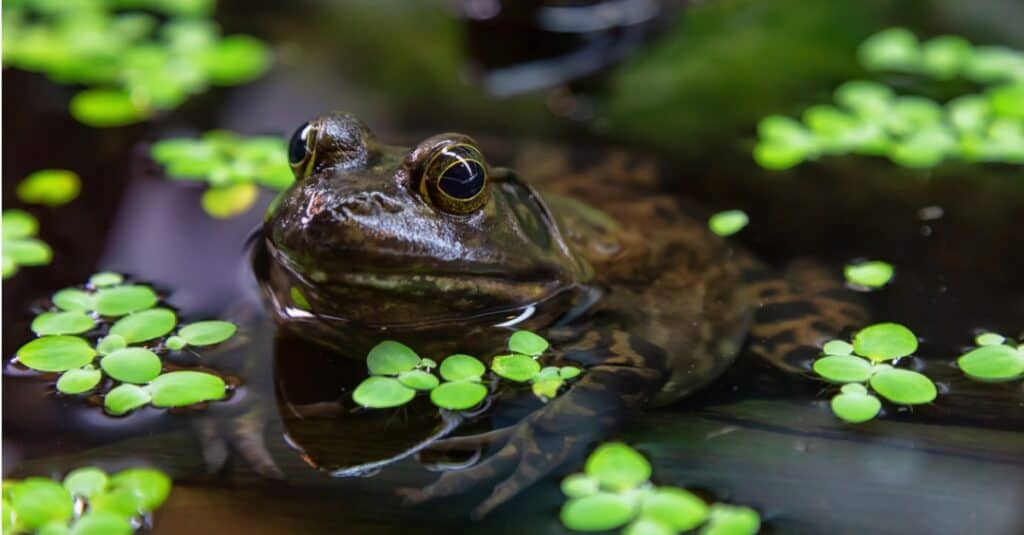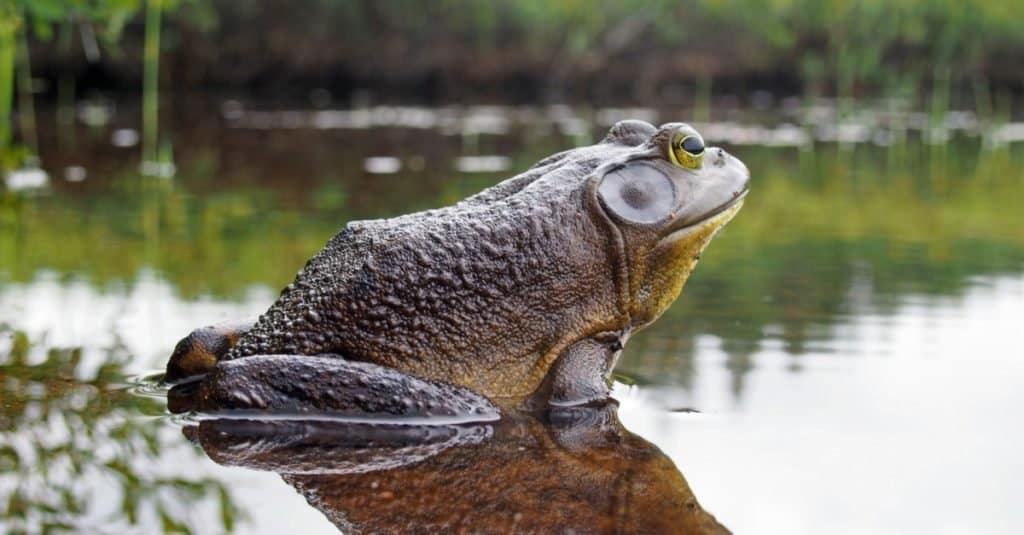Frogs are primarily carnivorous amphibians that vary in many ways but also tend to look similar. Two frogs that are often confused for one another, especially in juvenile stages, are the American bullfrog and the green frog. However, you can tell these animals apart with the right information. That’s why we’re going to show you a bullfrog vs green frog comparison.
We’ve established five different methods that you can use to tell the differences between these animals. Some are more obvious than others, but all can help figure out if you’ve encountered a bullfrog or a green frog.
Comparing a Bullfrog and a Green Frog

| Bullfrog | Green Frog | |
|---|---|---|
| Size | Weight: 6 oz-1lb Length: 3.5-6 in | Weight: 1-3 oz Length: 2-3.5 in |
| Morphology | – Dorsolateral folds go down behind the frog’s external eardrum | – Has prominent dorsolateral folds or ridges running down its body |
| Song | – Two or three-note song – Either “rum-rum” or “jug-o-rum” | – Single note calling – Sound is akin to plucking a string on a banjo |
| Range | – Natural range includes the Atlantic coast of North America up to Newfoundland and south throughout Mexico – Now found across most of the U.S. – Introduced in France, Japan, South Korea, China, and South America | – Eastern half of the U.S., parts of Southeastern Canada, and southern Mexico – Northern green frog lives from the Southeast to the Northeast U.S. and portions of Canada – Bronze frogs live in the South and Southeastern U.S. – Introduced into Northwest U.S. |
| Scientific Classification | – Lithobates catesbeianus | – Lithobates clamitans - Two subspecies, northern green frog and bronze frog |
The 5 Key Differences Between a Bullfrog vs Green Frog

Bullfrogs are known for spending a lot of time in or near the water.
©iStock.com/edb3_16
The greatest differences between a bullfrog and a green frog include their size and morphology. Bullfrogs weigh up to 1 pound or more while measuring 6 inches long and their dorsolateral folds turn downward after they pass the tympanum. Green frogs only weigh 3 oz and measure 3.5 inches in length while having a prominent dorsolateral ridge that runs down a significant length of the flanks on its body.
These are two differences that you can use to tell the animals apart by looking. Yet, there is more to these creatures than meets the eye. Let’s go further in-depth about these animals and show you what makes them unique.
Bullfrog vs Green Frog: Size
A bullfrog is larger than a green frog, and this size difference is a primary means to tell the two amphibians apart. On average, a bullfrog will grow to about 6 inches in length while weighing between 6 ounces and 1 pound.
The green frog is much smaller, weighing only between 1 and 3 ounces and measuring about 3.5 inches long on the high side of average. If you see a frog that’s about as long as a dollar bill, then you’re probably looking at a bullfrog.
Bullfrog vs Green Frog: Morphology
The bodies of bullfrogs and green frogs have many similarities. They both have similar colorings with green, brown, and some yellow possible on their skin. Moreover, they have bumpy, textured skin, large eyes, and webbed back feet.
However, these two animals differ in one major way: their dorsolateral ridge. These skin folds are very prominent on the green frog. They start behind the eye, surround the upper portion of the tympanum, and then run down the length of its flanks.
Yet, the same cannot be said about the bullfrog. In this case, the dorsolateral ridge runs behind the eye, around the tympanum, and then turns down on the frog’s cheek instead of running the length of the body.
You can see this difference with a glance, and it’s one of the simplest ways to differentiate between the creatures.
Bullfrog vs Green Frog: Song

North American bullfrog has a bellowing call.
©Christian Ouellet/Shutterstock.com
You can use the frogs’ song to tell them apart without seeing them. Both the bullfrog and green frogs have different calls that they make. For example, the bullfrog is a very deep two or three-note song. It has been likened to the creature saying “rum-rum” or “jug-o-rum.”
The only thing that makes it difficult to tell if it’s a bullfrog is if several of them have formed a chorus and are starting at different times.
However, the green frog only has a single-note song, and it’s known for sounding like someone is plucking a string on a banjo. They only sing one note at a time, making it hard to spot in a group with other frogs.
Bullfrog vs Green Frog: Range
Bullfrogs and green frogs live in similar areas, but they do have some differences. The green frog is naturally found in the southeastern portion of Canada, the entire east half of the U.S., and parts of Mexico. However, not all varieties of green frogs are found everywhere.
The green frog has two species, the bronze frog and the northern green frog. The northern green frog lives from the Northeast to the Southeast in the U.S. as well as the southeastern portions of Canada. Bronze frogs are found in the south and Southeast U.S. and in Mexico. However, some of them have also been introduced into the Northwest U.S.
In fact, the bullfrog has also been introduced to areas beyond its normal range for the sake of helping with pest control. The bullfrog originally lived on the Atlantic coast of North America, from Newfoundland all the way into the south of Mexico.
Nowadays, the bullfrog can be found throughout most of the U.S., along with places like France, Japan, South America, China, and South Korea. They were either brought to those places on purpose or as pest control measures.
Bullfrog vs Green Frog: Scientific Classification
The bullfrog and green frog belong to the same genus, Lithobates. However, they are certainly different species. The bullfrog belongs to Lithobates catesbeianus, and the green frog belongs to Lithobates clamitans. The green frog has two subspecies called the northern green and bronze frogs.
All told, these two creatures are similar to each other. Yet, by looking at their size, hearing their song, and examining their dorsolateral ridges, you can learn to tell these animals apart with ease.
The photo featured at the top of this post is © dwi putra stock/Shutterstock.com
Thank you for reading! Have some feedback for us? Contact the AZ Animals editorial team.






